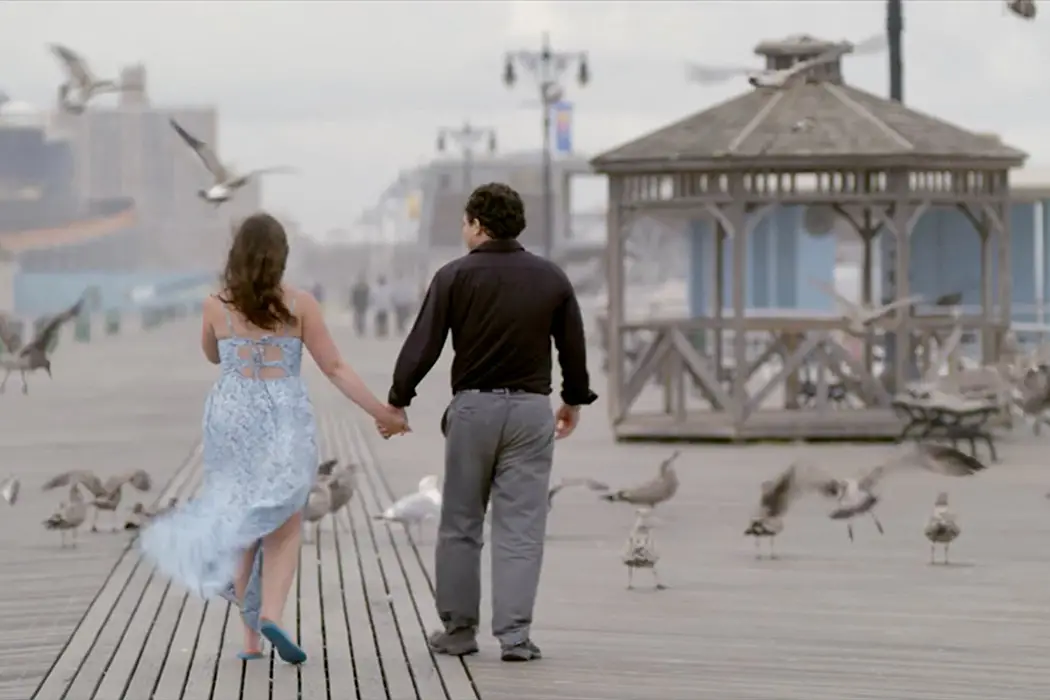KEEP THE CHANGE: A Breakthrough For Disability Films

Amyana Bartley is a screenwriter and producer. Her company, Queen…
Keep the Change is a revolutionary new romance/comedy about a couple living on the Autism spectrum. Using almost an entirely autistic cast, it is a groundbreaking, intimate portrait that humanizes and explores a vast array of people living with this disability.
A Seed Planted
When writer/director, Rachel Israel first met Brandon Polansky at a live model drawing class, she had no idea her life would be changed. Polansky, described by Israel as a young man who “struggled socially”, asked every single woman in the class on a date. When it was Israel‘s turn, she turned down the date, but gave him her number, thus beginning a friendship, that became the key to her new found passion.
Israel wasn’t even aware of what Autism was at the time, but through her friendship with Brandon, she was introduced to the Jewish Community Center of Manhattan’s Adaptions group. Adaptions creates social, educational and recreational activities for Autistic adults and their families. From Polansky‘s real life struggles with finding love, Israel first created Keep the Change as a short. As she got to know a host of amazing people who participated in Adaptions’ theater program, she knew she had enough characters and content to make it a feature.

Most features start with the script, but instead, Israel created a script around the people she wanted as part of the film. Creating the story around the people enabled the actors to be more comfortable and added to the authenticity of it. Although it is a fictional film, the characters are based on all of the actual actors. It took Israel years just to capture all of the footage she needed to put the film together. The results are truly special.
Keeping It Real
Brandon Polansky stars as David Cohen, a disgruntled man with autism, who is ashamed of his disability. He is required by a judge to attend the weekly meeting at the JCC Manhattan, because of a misdemeanor infraction. David’s greatest wish is to be seen as “normal” and find the love of his life. He feels embarrassed having to attend these meetings among the group of autistic people, whom he deems as “others”. He tries to get away with not participating while he’s there, until he is forced to be a part of a game, intended to get to know everyone in the group.
He is paired with Sarah, (Samantha Elisofon) who has autism, a learning disorder and is his literal opposite. Sarah is outgoing, vibrant and joyful. Elisofon shines as Sarah and is a remarkable treat to watch. When David and Sarah are assigned a task outside of the group, Sarah takes it seriously and has to hound David about getting it done. As they get to know each other, David can’t help but be pulled in by Sarah’s magnetism.

David’s habit of shame interferes in every part of their relationship, though, creating more barriers for their relationship and his connection to others in the group. While Sarah is expressive and open about how she feels, David continues to push happiness away, worrying about others’ expectations of him and his desire to appear “normal”. Can the relationship survive David’s insecurities and their individual disabilities?
The Need to See the Marginalized
In the current mainstream film industry there are a multitude of groups that are consistently left out onscreen. Though there is a large push nowadays from these groups to be seen, Hollywood still resists including People of Color, Women, LGBTQ+ and the disabled. It is, and has always been, on the shoulders of Independent filmmakers to bring to light much of what is happening in these marginalized groups. However, the price we pay as a whole for not including 3/4 of the world, is a huge disadvantage to our society.
There have been numerous studies on how representation in the media matters. It matters on how we see ourselves, other people and the world. When children are inundated on a daily basis by images of, primarily, one race and one gender, it can detrimentally shape their self esteem, making them feel unimportant and invisible. Film, made primarily through the eyes of white men, dictate to everyone else what their roles are in the world through stereotypes that rarely portray reality.
Film Twitter is alive with posts from people with disabilities that want authentic representation. They deem it unfair and “ableist” that an able bodied actor portrays someone with a disability, such as Eddie Redmayne‘s portrayal of Stephen Hawking in The Theory of Everything. Though many able bodied actors deem it a challenge to learn how to portray someone with a disability with authenticity, it is a slap in the face to actual actors with disabilities, trying to get work. No matter how wonderful a performance is, it will never be as authentic as a person with the actual disability portraying it. Just as Dustin Hoffman portrayed a man with autism in Rain Man, we only got to see one type of person, with one type of autism, played by someone without autism. To the abled world, one could extract that this was how all autistic people acted, but that simply isn’t true.

In Keep the Change, we see a vast array of spectrums, colors, genders, abilities and sexualities. We see different people, living and functioning with autism and other disabilities, thriving out in the world. We see the complexities behind their lives, their families, their relationships and yes, even their sexual lives. In other words, we see humans. In order for humanity to grow as a species and learn to accept differences as part of being human, it is crucial to see these differences authentically portrayed in media. Without it, the younger generations learn to accept harmful stereotypes as the norm, which is wholly destructive overall.
Keep the Change: Conclusion
Keep the Change exposes its audience to people with autism, in a day to day way that most films have not. I applaud the cast and crew for what they’ve done. The multitude of characters represented had vibrancy, life and depth. They made me laugh, inspired me and clued me in on a world I knew very little about. This film proves that it is possible to use actors with disabilities to create an impactful, enjoyable film that will resonate with audiences of all kinds. Its creation normalizes disability, the way it should, and calls attention to the need for disability inclusion, both onscreen and behind the scenes. It is a pioneer for a film genre that, I hope, can soon be consistently merged into mainstream.
We simply will not see change in our world without seeing change in our films. The industry owes it to humanity to reject the stereotypes it is so accustomed to using and embrace the much needed advancement of diversity present in reality.
What steps are you willing to take to see the advancement of diversity?
Keep the Change is playing in theaters across the United States. Click here for dates and locations.
Does content like this matter to you?
Become a Member and support film journalism. Unlock access to all of Film Inquiry`s great articles. Join a community of like-minded readers who are passionate about cinema - get access to our private members Network, give back to independent filmmakers, and more.
Amyana Bartley is a screenwriter and producer. Her company, Queen B. Productions, supports filmmakers of all walks, interested in creating thought provoking, moving projects. As her company grows, she will create "real jobs" for any talented artist, in front of and behind the screen, who is passionate about making a difference using the art of film.













